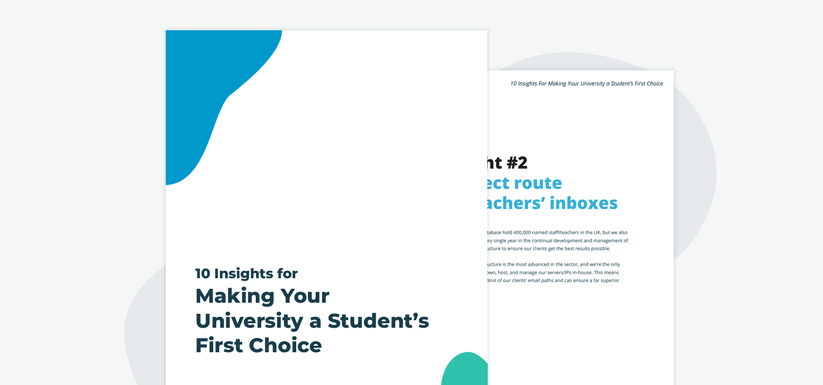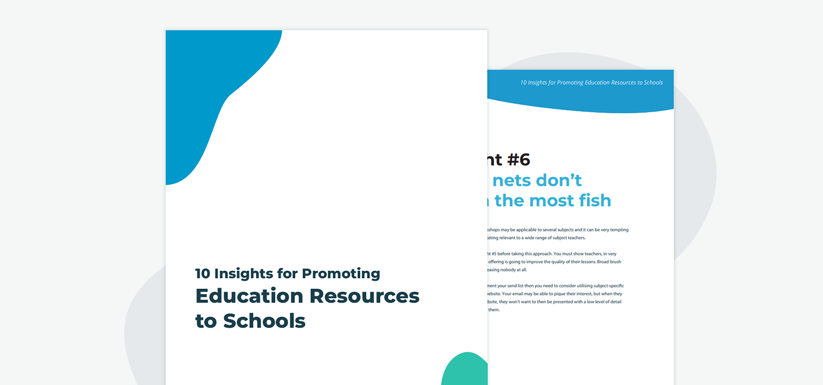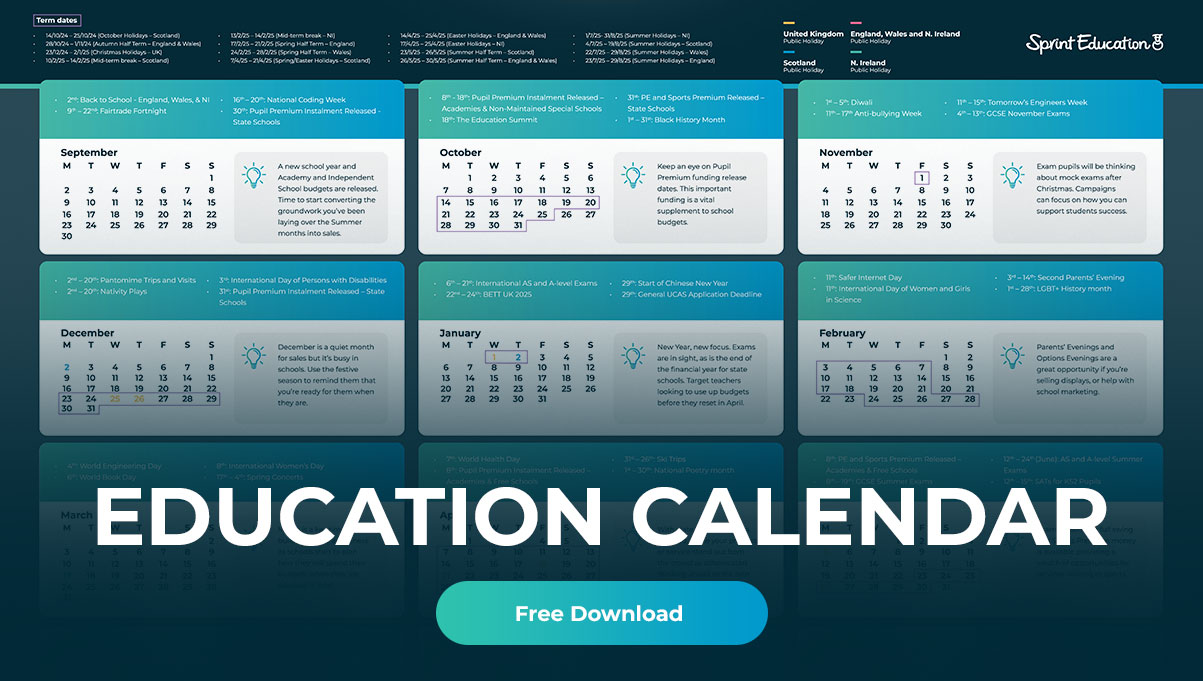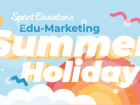The State of Inbound Marketing Trends 2022
The State of Inbound Marketing Trends 2022
Our Education Marketing Response to HubSpot’s Latest eBook
Our Education Marketing Response to HubSpot’s Latest eBook
About This Guide:
In summer 2022, HubSpot released their latest marketing eBook, containing all the latest benchmarks, insights, and resources to build a smarter marketing strategy.
We’re big fans of HubSpot, and know a lot of education businesses are too.
We know lots of you will have read this free guide, and may have jumped straight in to start pulling apart your own marketing strategies.
But before you do so, it’s important to remember HubSpot’s advice isn’t sector-specific, nor UK-centric.
Their data, insights, and predictions have been collated from over 1,600 B2B and B2C marketers around the world. All manner of businesses who require wildly different marketing tactics.
And in fact, their sample size is only half of the number of teachers and school staff who responded to our own 2022 research study, [the State of Selling to Schools](https://sew-prod.fra1.cdn.digitaloceanspaces.com/sew/public/uploads/academy/attachments/State of Selling to Schools 2022.pdf) (3,210).
In this free guide, we’re digging down into HubSpot’s stats to tell you exactly which of their findings apply to your education marketing campaigns, which are a must-avoid, and which are ones to watch as we head into 2023.
1. Emerging Trends in Marketing and Marketing Benchmarks
Social Media Marketing
One common theme that’ll come up countless times during this report is social media marketing. And we’ll kick things right off on that front by reporting on one of HubSpot’s biggest findings: in 2021, social media was the top marketing channel, and it held strong in 2022. Twitter Spaces, YouTube Shorts, Instagram Live Rooms, Facebook Live Shopping, and Spotify Greenrooms are the top five new/emerging platforms marketers are investing in for 2022.
But, as we know, only 3% of teachers said they’d be most likely to respond to communication via Twitter, Facebook, or LinkedIn – the lowest-rated method of communication across our whole survey. And while Facebook was voted the second communication tool that teachers engage with most regularly, over half of teachers say they check Facebook less than once per day. Comparing this with our email stats, school inboxes see 303% more views than Facebook per day – or 1.9 billion more over one academic year across the whole UK education sector.
Social media is mostly used by people to connect with friends and family. Therefore, it’s less likely that teachers will be as keen to engage with marketing messages when not in work mode.
As HubSpot have proved, social media is a huge winner for many marketing businesses, but the key difference here is they’re likely B2C businesses. If you catch someone in their personal downtime and you’re marketing your fashion, holiday, or restaurant business, you’ve appealed to their ‘me time’ by giving them even more to indulge themselves with. But if you’re marketing textbooks, school trips, or resources, they’re not going to want to pull themselves back into work mode and be reminded of what they’re relaxing from, and will be far less responsive.
So, yes, these emerging social media techniques like YouTube Shorts are new and exciting. But, simply put, social media is by the worst platform to reach teachers on, and really isn’t worth diverting your marketing spends to.
Top 5 Marketing Trends in 2022
When asked, “What trends are you currently leveraging?”, HubSpot’s respondents answered as follows:
Influencer marketing: 34%
Mobile-friendly website design: 33%
Short-form video content: 31%
Virtual events: 31%
Experiential marketing: 29%
As we’ve just discussed, social media marketing really isn’t a good choice for an education business both in terms of spend and results (and actually, this is likely the case for other B2B industries). So, jumping on the $16B-dollar influencer bandwagon won’t pay off nearly as well as it does for B2C businesses – but the general idea isn’t something to be ignored.
User-generated content such as testimonials, video case studies, and even emails written by teachers on behalf of your business are a great way to increase the success of your education marketing strategies. It all boils down to the fact that consumers – including teachers – are more likely to buy from other consumers rather than a business.
Mobile-friendly website design may have done well to secure second place in HubSpot’s results, but it’s surprising to us that just 33% of marketers voted this as an important trend. We hope this because they already perfected their mobile-friendly website designs several years ago – as we all certainly should have. Smartphones are far from being considered new technology. Over 50% of education emails were being opened on mobile back in 2019, so that number could have easily climbed to over 60% by now.
At Sprint, we make sure all of the emails we design are fully optimised for mobile, so it’s important your websites are just as capable and easy to navigate as their desktop counterparts to ensure a steady transition from email to website.
Teachers will spend an average of 13 minutes on your website as opposed to just 11 seconds reading your email, so this is super important!
Videos and virtual events are both hugely popular within schools. Our 2022 State of Selling to Schools study revealed that almost 70% of teachers would likely, very likely, or definitely respond to an email promoting a free webinar. It’s by far the easiest virtual event for a business to organise, but just think of all the possibilities of events you could hold with a bit of creative thinking that would prove even more engaging with teachers! And speaking of engagement, we’ve seen email click-through rates increase by up to 96% by including a linked screengrab of your video, while including a video on your landing page can help to increase conversions by up to 86%!
Experiential marketing, also known as live marketing, is a newer marketing trend that’s seen great success in recent years, although dampened somewhat by restrictions during the COVID-19 pandemic. Experiential marketing will often have digital components, but are largely run in-person, such as pop-up stores or mobile events.
This isn’t something that education businesses have largely explored thus far, although the groundwork is certainly there – running stands or events at the BETT show for example is a perfect introduction, and will give businesses a starting point and ideas for how they can hold their own independent event.
Top Marketing Channels in 2022
As we’ve discussed, social media is, so far, the number-one channel for HubSpot’s users for the second year running securing 44% of the vote. Following up almost neck-and-neck are website and blogs (36%) and email marketing (35%).
From our education-focused research, our stats are staggeringly different: 91.4% of teachers surveyed in our 2022 State of Selling to Schools research study said that email was the method of communication from education businesses they were most likely to reply/react to. This has increased from 88.3% in 2021, so email marketing really isn’t going anywhere!
Email communication is an effective but unobtrusive way to engage with teachers. We only ever email teachers work email accounts about products and services that will benefit their school.
The benefit of emailing work-only addresses is that teachers actively need to log into their work account.
They will be expecting emails related to their job, and they will likely be in the right frame of mind to engage with this kind of content.
Circling back to your website and blogs, hopefully you know how important engaging, technically sound websites and landing pages is to your audience. And blogs, too; 60% of teachers will likely, very likely, or definitely respond positively if you include a blog as your email’s main CTA, not to mention how incredibly beneficial they are for SEO purposes.
2. Content Marketing Trends
Content marketing should be a top priority for every education business, utilising a range of multimedia formats to make your marketing more interactive and accessible to your audience.
Content marketing is a great way to be present, show authenticity in your marketing, and feature that user-generated content we’ve just discussed.
The most common (and successful) trend here is video marketing, used by 59% of HubSpot’s users, which we’ll touch upon in more detail in chapter six. But other popular formats include blogs (48%), images (46%), infographics (45%), and case studies (42%). All of these are not only incredibly easy, but highly recommend that you incorporate into your education marketing strategies. Granted, some of these will take a bit more time to put together than a simple, plain-text marketing strategy, but a mix of emails will generate greater results in your marketing campaigns. And as a bonus, that interactive content is the perfect way to collect rich first-party data. Whether it’s a poll, a calculator, or some sort of quick form, you can gather the data that’s most important and helpful to you directly from teachers themselves.
Most Effective Content Marketing on Social Media
It’s important to take this with a pinch of salt, as what’s successful on social media won’t always be the same for email. But, when you’re emailing time-crunched teachers, those quick types of content that tend to be popular on social media are definitely ones to pull out for your next email marketing campaign.
It’s important to use content that matches your brand identity, and fits the purpose of your product or offering. The most effective content is entertaining and interactive, but those funny posts just don’t suit every brand, particularly those working in the education marketing agency, so it’s not a good idea to try and shoehorn those into your marketing strategies to try and capitalise on that increased engagement, as it could backfire spectacularly.
And unfortunately, restrictions with email clients, particularly Outlook which is a favourite amongst school staff, don’t allow for fully futuristic functions such as radio-button polls or GIFs that work properly. But that doesn’t mean you shouldn’t try. You can still set up a poll on your email, and have each option link to a different landing page that’s most relevant to a teacher’s preference. And you can still make use of GIFs, as long as you’ve set the correct dimensions and fallbacks to work across as many email clients as possible. With a bit of creative thinking, it’s definitely possible to make use of these popular trends in your education campaigns.
Other popular trends are even easier to capitalise on. ‘Trendy’ content such as breaking news stories, relatable content such as teachers’ pain points, and behind-the-scenes glimpses are super easy to base a new blog, video, or even your entire email on. In fact, we have a bank of dynamic themes that we use to inform your email campaigns, and we have three that perfectly fit each of these trends to a T. So you don’t even have to think about this one yourself – simply ask us to do it for you!
Judging by our own research, this is proven to pay off. 65.6% of teachers would appreciate being sent a free guide or eBook to read, and 60.2% would appreciate a helpful blog article. We’ll go into the benefits of emailing teachers a video later, but for an early hint, that’s another sure-fire success with teachers.
Content Marketing Trends to Watch in 2022
It’s no surprise that the top five categories that HubSpot have deemed ones to watch were ones that came high on their list of effective trends. Interactive content, behind-the-scenes content, content that reflects your brand’s values, funny content, and relatable content are predicted to still be the most effective throughout the remainder of this year. Content marketing is on the rise, and truly isn’t going anywhere, so make sure you jump on this trend sooner rather than later – without sacrificing quality, of course!
With that, we’ll end this chapter with an important summary from HubSpot themselves:
“If your strategy still doesn’t include the creation of an owned channel with great content, that’s the obvious first step. Having your own blog, podcast, or newsletter is no longer optional if you want to cover the entire customer journey. You can’t simply rely exclusively on building on “rented land” - PPC or Social Media - because that means that you’ll be hostage to an algorithm that could change at any time. Each person that chooses to actively go after your content, your brand, is worth a hundred times more than a single Instagram follower or someone who just found your blog on Google and never returns. We must create a journey that turns these one-time visitors into fans of our content and our brand.”
3. Social Media Marketing Trends
We’ve discussed the fact that social media marketing isn’t the best choice for education businesses – but it’s still important to know how other businesses are conducting their social strategies to stay up-to-date with the industry, and be ready for anything if the landscape changes.
To start things off, here are HubSpot’s three main findings from 2022 so far:
- Instagram, YouTube, and Facebook are the top three social media platforms.
- The number-one social media challenge for marketers is creating engaging content.
- Marketers are investing the most in live-streaming and short-form video content.
Video
It really is worth paying attention to these facts. Many people forget that YouTube is considered a social media platform, but it’s far more useful to education businesses than platforms such as Facebook. As we’ll cover in a later chapter, video is hugely beneficial to your marketing campaigns, and YouTube is the most popular platform to upload yours. You will need to proceed with caution, as YouTube (and other social media and video sharing platforms) will be blocked on some school networks. This is a smaller issue than in previous years, as more and more teachers are viewing their work emails on their mobile (where they may be using their own mobile network and not the school’s WIFI), and more in the evening at home, where restrictions wouldn’t apply. There’s also the issue of losing teachers’ attention to other YouTube videos: you send them to watch your video, and instead of closing the website and visiting yours instead, they fall down the ‘YouTube rabbit hole’ and watch five funny cat videos in a row – not the action you probably intended!
To combat this, embed the video on your website, so they’re more likely to stay and browse after watching the video. Also consider an alternative video platform, such as Vimeo or Wistia, which are less likely to be blocked if the school has to manually list websites to exclude from their network.
When it comes to your ROI, Facebook continues to be the dominant platform, providing the best value to both B2B and B2C organisations. But, there’s one drawback: Facebook is suffering from lower engagement rates due to the rise of those popular livestreaming and short-form video platforms, such as TikTok, Instagram, and YouTube, and it’s showing less promise for the future. In fact, 63% of businesses plan to increase their investment in TikTok this year, compared to just 43% who’ll increase their Facebook spends.
In 2022, creating engaging content was voted the biggest challenge by 27% of businesses. As we’ve discussed, it’s hard to capture teachers’ attention with business-related content when you’re communicating with them in their own time on their personal social media platforms – not to mention when you’re competing for attention amongst millions of other entertaining pieces of content. Here’s what HubSpot’s social media professor Crystal King has to say:
“From the addition of Reels into Facebook, to the rise of YouTube Shorts, and TikTok overtaking Google as the most popular domain, the great shift to short form video is in full-swing. The platforms are increasingly placing priority on highlighting short form video in their algorithms, and if you aren’t already exploring the use of this medium, now is the time to start. TikTok has the biggest viral advantage for native content and the good news is that tapping into it doesn’t have to cost a lot of money, just a bit of creativity."
2022 Social Media Marketing Challenges
What other struggles have businesses reported in 2022? Here’s what else HubSpot reported:
Reaching your target audience has always been a huge issue for social media. While it is possible to set up social adverts on Facebook targeted to the job roles teachers provided, it only works with those bigger roles such as Head Teachers or Secretaries. You’d tend not to list your role as ‘Head of Year’ or ‘Key Stage Head’ on Facebook; you’d probably just put Teacher, or Senior Leader at a push.
And some job roles such as Governors wouldn’t show either, as they’re usually made up of those working other roles in the school, or parents and other volunteers of the local community. And it’s impossible to target by job role on other platforms such as Twitter or Instagram, because you don’t provide that information when you sign up. This means you’ll end up paying for clicks and views from people for whom the advert isn’t at all relevant.
So it’s no wonder email is more popular: when you can target super-specific job roles, and send emails directly to teachers’ inboxes personalised with their name and location, you’ve got a far higher chance of success than sending a message out into the wilderness of social media, and hoping it just happens to land in the laps of the right people.
It’s also significantly easier to measure your ROI, and track results in line with your email marketing. All of our campaigns come with tracking reports and databases of qualified leads so you’ll know exactly who’s interacted with your email!
Social Media Marketing Goals
In 2022, the primary marketing goal for businesses was to advertise their products and services – compared to 2021, where their main goals was to increase their brand awareness and reach new audiences. It’s likely this shift has come both as a result of the struggles businesses are facing, as well as the shift in popular platforms that have made some goals easier to achieve.
For example, reaching new audiences is significantly easier on Instagram, which is the most popular platform amongst HubSpot’s audience this year (used by 67% of businesses), compared to Facebook. Even just a year or two ago, you’d be relying quite heavily on social sharing and paid advertisements, whereas now social media success is weighted very heavily on algorithms that bring new content to people’s feeds. Fewer businesses have reported this as their primary goal this year, which could mean one of two things: they’ve already made the shift to alternative platforms or have tailored their content to play to the algorithms, or they’re sticking with their old methods and have realised this is no longer as tangible a goal as in previous years due to the heightened levels of difficulty.
Advertising their products and services was actually the lowest-rated goal of the six reported in HubSpot’s report in 2021, but now takes the first place in 2022. This could be for a multitude of reasons, and of course depends a lot on what specifically the product or service is as to how well it can be marketed to on social media. But many businesses have dipped their toe in the water of combining the entertainment factor with a soft-sales approach to get their products in front of more people, making this far easier to achieve.
Social Media ROI
Given how popular video content is this year, it’s no surprise to learn that short-form video has the highest ROI this year out of any other type of content. But it may be a surprise to learn that infographics, user-generated content, and memes also perform fairly well in terms of ROI. User-generated content and infographics are something you should be using for your emails anyway, so it’s worth spending a moment posting these on your social media pages – and planning plenty in your email strategies going forwards!
4. Email Marketing Trends
Here’s the chapter we were all waiting for! Our own internal research has proven the effectiveness of email marketing in the education industry: UK teachers check their inboxes 1.9 billion times each academic year, and 91.4% say they’re most likely to react to marketing emails more than any other method of communication.
How do HubSpot’s findings compare? Well, things are pretty close across the board. 95% of HubSpot’s users feel that email marketing efforts are effective in meeting their inbox goals, and some of the best strategies include email personalisation, writing effective subject lines, and making emails mobile-friendly – things we recommend to you on a daily basis!
In 2022, the top five uses for email marketing, according to HubSpot’s research, are:
- Improve customer loyalty and retention.
- Increase revenue/sales.
- Generate leads.
- Generate website traffic.
- Increase brand awareness.
We think this is pretty accurate for education marketing emails, too, although our approach with any strategy is to focus more on buildings leads, brand recall, and customer retention. Sales-heavy emails can be great for immediate sales, but there’s no longevity – you won’t generate as many leads as you would going for a longer approach. That’s why we recommend a series of at least three emails within any strategy; the first two build those leads, while the third capitalises on their hard work and helps you convert them into sales, or at the very least continue to nurture those precious leads.
The Cost of Email Marketing
Thanks to the input of Litmus, HubSpot’s trend report also revealed that email marketing delivers a $36 return for every $1 spent. In terms of lead generation, our own research shows it costs an average of £27.50 to generate a lead within the education marketing industry – but with Sprint, we bring that cost down to just £5.47 on average!
Top Marketing Channels by Effectiveness
Despite social media consistently coming out on top in HubSpot’s research, it’s actually only fourth on their list of effective marketing channels – with email marketing taking the first spot:
- Email marketing
- Paid search/ads
- Organic search
- Social media
- Events
- Direct mail
- SMS or Push
- Video
- TV or radio
- Outdoor media
- Podcast/voice
As mentioned previously, our own research states 91.4% of teachers prefer email marketing to any other method of communication. This is followed by postal mail at just 3.9%, and education publication adverts at 1.8%. This doesn’t take into account any SEO techniques, which are hugely important for your business to guarantee a successful search engine ranking.
But why is email marketing so effective industry-wide? Take it from HubSpot’s own words:
“Email continues its reign because it’s one of the rare channels marketers can (and should) use to form a direct customer connection. Email is the first place to measure if an audience is engaging, and offers multiple opportunities for meaningful engagement.”
Email communication is an effective but unobtrusive way to engage with teachers. We only ever email teachers work email accounts about products and services that will benefit their school. The benefit of emailing work-only addresses is that teachers actively need to log into their work account. They will be expecting emails related to their job, and they will likely be in the right frame of mind to engage with this kind of content.
Emails are also quick to delete, and all emails sent by Sprint Education are simple to unsubscribe from – it just takes two clicks for a teacher to remove themselves from all our future communications. The option to quickly opt-out isn’t as simple for all the other communication methods listed, particularly social media.
5. Digital Advertising Trends
According to HubSpot, 80% of brands are using paid social media advertising in 2022, and Facebook and YouTube are the most popular places for companies to spend their advertising budget.
One HubSpot employee states: “… in order to effectively build awareness for your brand, you need to take a multichannel, surround sound approach.” Here at Sprint, we don’t always think this is necessary – we’ve seen thousands of education businesses over the years do extremely well simply off the back of a strong email marketing strategy. A great website filled with blogs, videos, and other engaging content, backed with SEO techniques and Google advertising, will certainly help your efforts go a long way. But we’ve seen businesses with simple, even outdated websites go well beyond their email campaign goals.
HubSpot’s research once again reinforces brands’ social media presence, with 80% using paid social media advertising, and Facebook and Instagram coming out on top in terms of ROI.
Our own research does show Facebook is the most popular of the three main social channels used by education businesses (Facebook, Twitter, and LinkedIn), but 53% of teachers still say they only check Facebook less than once per day, and just 0.9% say it’s their favourite communications channel.
With that, it’s hard to see why any education business would invest in social media marketing, despite HubSpot’s research.
A rising number of HubSpot’s users are breaking away from the main social media channels, and testing paid campaigns on TikTok, Tumblr, Reddit, Twitch, and Pinterest. Several years ago, Pinterest was one of the bigger social media channels in the education industry, as teachers would regularly pin ideas for their classroom and school, and would actively be hunting for new products and ideas. While this is certainly still the case, Pinterest is no longer as talked-about as it used to be within the education industry – but it’s certainly still worth experimenting with.
6. Video Marketing Trends
We all know what they say: a picture tells a thousand words. And here’s one you might not have known – one minute of video is worth 1.8 million words!
So it’s no wonder that HubSpot’s research gave us some eye-opening stats:
• Short-form video has the best ROI compared to all other media formats. • One in three marketers plan to invest the most in video marketing in 2022. • 49% of marketers find video to be one of their most effective strategies.
And we whole-heartedly agree. Teachers are some of the most time-crunched (and most emailed) employees, so they’ll be much more likely to dedicate 30 seconds to a video than spending a few minutes reading your ‘how it works’ page, for example.
Simply using the word “video” in your email subject increases open rates by 13% on average. And we’ve seen click-through rates improve by a staggering 96% when including a hyperlinked screengrab of a video in the email!
Teachers will find a short and snappy 60-second video a lot more interesting than three paragraphs of dry descriptive text, and it gives teachers first-hand experience of your offer.
If you’re providing schools with an incredible offering, then video is a great way to showcase your people and start building relationships with teachers. Whether that’s breath-taking footage from a school trip, a walkaround of a classroom renovation, or even a walkthrough of your new app or piece of software, it’s going to be far more engaging, informative, and helpful than a bog-standard email. Of course, you’ll need to put some effort in to put together a high-quality video, and be conscious of its length.
Social Media Video Marketing
If you do plan on dipping your toes into social media, then video will be one of your best forms of content. Social media apps continue to prioritise video over static images, and receive roughly 125% more organic reach than a photo. 100 million hours of video are watched each day on Facebook alone! It’s important to remember what we’ve said all along – that teachers are using social media to be entertained, and not to think about work. But if your product or offering can slot into that entertainment category, then you may be in luck.
Video Consumption
Fortunately, it’s not just social media where video views shined. 2021 was a record year for video consumption. Video hosting platform Wistia saw almost 4.7 billion video plays last year, a 5% increase from the previous all-time high in 2022, and a jaw-dropping 77% more than 2019. Wistia’s users watched 14.6 million minutes of video in 2021, up 20% from the 12.2 billion minutes in 2020, and up 121% from 2019.
HubSpot and Wistia’s helpful research has also reinforced the point that short-form video is the way forward, with 5.3 million (almost a third) of all uploaded videos being less than a minute long.
This ties in perfectly with our stance on video content – keep it short, keep it sweet, and keep those teachers engaged with your offering!
That said, you shouldn’t completely forget about long-form video (typically anything lasting longer than 30 minutes). Long-form content is the fastest-growing category of video; videos lasting between 30-60 minutes nearly tripled on Wistia since 2019, and those lasting longer than an hour have nearly quadrupled.
Out of these videos, Wistia’s users reported that webinars received the most engagement from viewers. This is great news for you, as webinars and similar online events require less editing, and great for teachers, as 68.6% told us they’d likely, very likely, or definitely respond positively to an email promoting a free webinar.
Videos in 2022
2022 is shaping up to be another big year for video. Marketers are finding out just how valuable videos are to their strategies, and stepping up their game. More than 72.4% are planning on branching out and creating new types of videos, with their main video marketing goals being to drive brand awareness, educating consumers about their products, increasing engagement, and generating leads. This indicates that brands are seeing video impact at every stage of their customer’s journey.
What’s our recommend? For you to do exactly the same thing!
Focus on producing those high-quality, informative videos, and let your product do the talking for you. Feature them front and centre of your next email campaign (whether that’s your very first outreach, a follow-up to a brand-new lead, or a nurturing campaign sending to your long-time customers), and get ready to see your engagement levels surge.
7. Influencer Marketing Trends
As we established back in the first chapter, influencer marketing isn’t particularly relevant for education businesses, and our social media findings within education don’t reflect HubSpot’s in their wider audience. But, the essence of asking teachers to contribute to user-generated content is a great idea, and one that should be firmly on the table when planning your next marketing campaign.
Diving deeper into the topic of influencer marketing highlights the stark differences between HubSpot’s audience and the education industry. 88% of HubSpot’s survey respondents have a dedicated influencer marketing budget, with most spending between $50K to $500K or more annually. In contrast, the annual marketing budget for education businesses in 2021 was £25,915 (roughly $31K). Bearing in mind this is their full marketing budget, which is smaller than the smallest portion HubSpot’s clients are setting aside just for their influencer marketing!
What this does tell us is that it’s important not to read too much into HubSpot’s exact data for your education marketing trends. Their clients are typically much larger than many of the small family businesses populating the education marketing space, and even those that aren’t are working across vastly different industries. So don’t fret – but do pay attention as HubSpot’s research is certainly worth keeping in mind.
Working with Influencers and Creators in 2022
When we hear “influencer”, a lot of us will immediately think of those big names on Instagram with millions of followers. But there are several tiers of influencers – and actually, only 29% of HubSpot’s businesses work with influencers with over one million followers. The most favoured tier used by 67% of businesses are ‘micro influencers’, or users with between 10K and 100K followers. You’ve also got the nano influencers, who have between 1-10K followers, which work with 41% of businesses.
This is great news for you, because there are plenty of ‘nano’ and ‘micro’ teacher influencers out there to reach out to to support your user-generated content strategies.
These tiers of influencers make even more sense when you hear what marketers are looking for when partnering with them:
- Content quality.
- Engagement rate.
- Alignment with company values.
- Aesthetic/branding.
- Expertise in a particular industry.
With issues surrounding those ‘mega influencers’ such as bought followers and bot likes, it’s no wonder brands are preferring those smaller influencers to generate higher-quality content. These influencers are willing to put the work in to build their brand, ultimately resulting in better adverts which, in theory, should generate a higher engagement rate.
It may also be a surprise to learn that making sales isn’t the number-one goal for influencer marketing:
- Increasing brand awareness and reaching new audiences.
- Improving brand reputation.
- Growing your brand community and social media following.
- Increasing revenue and sales.
- Increasing customer loyalty.
This should very much be the same angle for your own social media posts. Social media isn’t an ideal edu-marketing platform, but often teachers will search your brand online to check your social media pages, so it’s never a good idea to leave them empty. Even just a few occasional yet well-thought-out posts will keep your social media ticking over to let your clients know you’re very much still in business!
And it should very much be the same for your email marketing campaigns. While your ultimate goal will be sales, your immediate goal must be to increase brand awareness and build your audience to later convert to sales – which is where that golden user-generated content comes into play.
Effective Influencer Campaigns
It is a bit of a surprise, then, that HubSpot’s customers are using the below to measure how effective their influencer campaigns are:
- Revenue/sales.
- Brand awareness.
- Impressions/views.
- Brand mentions/hashtags.
- Clicks.
Consulting the former list of goals, sales aren’t mentioned until the fourth point, and the focus is on brand awareness and building their audience base. So you’d then think that customers would measure effectiveness based on exactly that – more likes and followers, more website hits, and so on. Sales should really be further down on that list.
As we’ve said many times over, social media isn’t even a worthwhile platform to use to contact teachers, never mind aim to generate sales. So this certainly isn’t something you should follow with your education emails.
To further reassure you that you’re making the right decision by not prioritising social media, HubSpot have listed the top five categories for influencer marketing campaigns:
Fashion, fitness/health, travel, beauty, family
Social media is very much a downtime activity, and so it’s no wonder none of these categories are to do with work. Teachers want to relax and unwind when they visit social media, and explore topics that suit their personal lives. Contact teachers via email, which they’ll only check when they’re already in, or ready to be in, work-mode, and you’ll generate far higher levels of engagement.
8. B2B and B2C Marketing Trends
While through Sprint you’re emailing teachers directly, it’s important to remember you’re doing so at their work address. While they’ll personally use your product, the decisions are made in a group using school money, so it’s a B2B process.
One of HubSpot’s key findings on B2B trends summarises one of our points perfectly:
“B2B brands are more likely to use LinkedIn and find it effective, but B2C brands are more likely to feel that billboards and physical ads are more successful.”
While a social media platform, LinkedIn is very business-heavy, so, much like when they log in to their inbox, teachers are in work mode, or at least know that’s what to expect.
That said, our own research confirms LinkedIn is the least effective of the main three social platforms for teachers. Just 0.8% of teachers are most likely to react to a LinkedIn message, compared to 0.9% who voted Facebook adverts/posts, and the 1.8% who voted for Twitter adverts/posts. Over 90% of teachers say they don’t check their LinkedIn feeds on a daily basis, which is, again, less than Twitter and Facebook.
This once again solidifies the fact that the education marketing industry is so different from most other industries, and general marketing advice should be taken with a pinch of salt!
Despite this, a lot of HubSpot’s other B2B findings match what we know about staying successful in the education industry:
• B2B brands find inbound marketing and SEO to be more effective than B2C brands. • B2B brands have seen better ROI from inbound marketing and SEO than B2C brands. • B2B brands are more likely to use blogs, case studies, whitepapers, and interviews. • B2B marketers are more likely to prioritise SEO than brand partnerships.
There you have it – almost HubSpot’s own words that you shoudn’t be worrying about social media, as your best chance of success is to focus on your website and its content, and of course the king of inbound marketing: emails.
9. Future Marketing Predictions
What do HubSpot predict we’ll see a rise in during the remainder of 2022 and beyond – and how does that relate to education businesses?
1. More B2B brands on TikTok.
With the rise and marketing power of short-form video, it’s no wonder TikTok, one of the original micro-video platforms, is the leader of the pack. Targeting a younger demographic than the likes of Facebook or LinkedIn, TikTok is a great way to reach newly qualified teachers – but perhaps less-so educators in a leadership position.
As we’ve mentioned throughout this guide, video is a must for any education business – but our research shows social media should never be prioritised over your email marketing campaigns, and you shouldn’t invest time and money into social media platforms if you’re expecting a huge ROI.
TikTok is also almost entirely entertainment-led, so you’d find it almost impossible to achieve any sort of success by posting hard-sales videos. But, if your product or service, and your brand guidelines, allow for some playful content, funny captions, and a younger approach to your marketing, it’s certainly worth a try. Think joining in viral dance routines to show off your theatre-in-education performers, gorgeous scenes on your school expeditions, or even a quick comedy sketch around your furniture workshop!
2. B2C investment in SEO, content marketing, and podcasting.
77% of B2C marketers, and 66% of B2B marketers, report using SEO. If your education business isn’t doing so, you need to make this one of your top priorities right now. Optimising your loading speeds, landing pages, topic cluters, and pillar pages will help more teachers find and connect with you online, and have a more positive experience with your brand.
More and more businesses will be dipping their toes into more advanced SEO and marketing tactics, so it’s important you follow suit to avoid being left behind.
Content marketing is a great way to not only optimise your SEO, but your emails, too. As we’ve discussed, video marketing is a major trend for 2022 onwards, and other popular types of content including blogs, infographics, and case studies will help add variety to your emails, increase your engagement rates, and generate more education leads for your business.
Podcasting isn’t something that’s been hugely explored by education businesses, mostly because of the time and cost you’d need to invest in a high-quality series. But it doesn’t mean you should immediately write it off. According to Statista, there was an estimated 21.2m podcast listeners in the UK alone in 2021. That’s a huge, relatively untapped market in the education marketing industry, and one businesses with more resources should certainly consider!
3. AI and machine learning in marketing.
It might sound intimidating – but it’s likely you’re already using an AI or machine learning app without realising it! Whether you’re cleaning data, optimising content, improving your SEO, and more, it’ll save you and your team time and money. According to HubSpot, 17% of marketers are integrating automation or artificial intelligence like chatbots and segmentation into their strategy, and 43% agree they’ve been the most effective trends for their organisations growth. This is likely to rise significantly over the next year.
It's important for all business to invest some time and energy into incorporating these new trends, as not only will they make your business savings, but teachers are going to start expecting to see these future-forward techniques when they connect with you, your website, and your marketing, because other businesses will be doing the same. To reassure teachers that you’re innovative, and on the forefront of technology and development inside and outside of your industry, you’ll need to make this one of your future priorities.
4. Automation and growing investment in marketing and revenue operations.
According to HubSpot’s research, 78% of media planners use automation to save manual time, and improve the customer experience and business performance. Businesses will find new and creative ways to use automation in their day-to-day roles and for the larger marketing organisation, and, again, it’s important you do the same.
It's a relatively new and therefore turbulent market, so not something you need to dive into overnight. But starting to explore your options of software or technology to streamline your teacher funnels, lead nurturing, or even content creation will free up to your time to allow you to focus on your sales.
5. Short form video (organic and paid ads).
95% of marketers currently using short-form video plan to maintain or increase their investments later in 2022 and beyond, as it’s proven to be the most effective media format for marketers. Most brands will be considering the social media side of things more, focusing on platforms such as TikTok, Instagram, and YouTube. But we know that education marketers should be diverting their time and energy onto their email campaigns – where including a linked screenshot of a video is incredibly engaging to time-crunched teachers.
If you haven’t already, start exploring video platforms, do some research into what teachers want to see from you, and plan out some high-quality videos that you can take centre stage in your email campaigns.
6. Influencer marketing and the creator economy.
34% of businesses utilise influencer marketing, but we know this isn’t really applicable to education businesses as social media doesn’t get the engagement rates within the education industry as others. But the user-generated content we discussed earlier will help you achieve many of the same goals as influencer marketing does, with the benefit that it works spectacularly in emails where you’ll see a much higher ROI.
If you’ve got some close teacher contacts, ask them if they’ll collaborate with you on some content projects, such as free guides, video case studies or putting their name to your next marketing email. And if not, you can still ask your audience for some smaller-commitment support, such as testimonials or photographs of your product/service in situ.
10. Conclusion and Methodology
In summary of these findings, we think HubSpot themselves puts it best:
“The future of marketing is bright, and powered by creatives.”
The education marketing industry is as ever-changing as education itself; you need to be flexible with your marketing, and ready to adapt to whatever is thrown at schools. You need to constantly test new approaches to remain at the forefront of innovation, and show schools you’re the leader of the pack. You need to explore different types of content, and unleash your creativity to create email marketing campaigns, landing pages, value assets, and more to engage your teacher audience and build those essential long-term leads.
But first: get in touch with our education experts.
We can help you plan, schedule, create, and send your most engaging email strategy yet. Put our years of research and expertise to the test, and get ready for your most successful year yet.
Tags
Education Marketing
Inbound Marketing
Marketing to Education
Similar Articles


Marketing Universities to Schools
Learn 10 game-changing insights to make your university a student's first choice by enhancing your education marketing campaigns when emailing schools.


Marketing Education Resources to Schools
Learn 10 game-changing insights especially for education resource providers to enhance your education marketing campaigns when emailing schools.


Expert marketing to schools support and solutions
Expert marketing to schools solutions
Email Head Teachers, Teachers, and Staff Inboxes
Email teachers and staff inboxes
Sell More to UK and Global Schools and Colleges
Sell more to schools and colleges

































